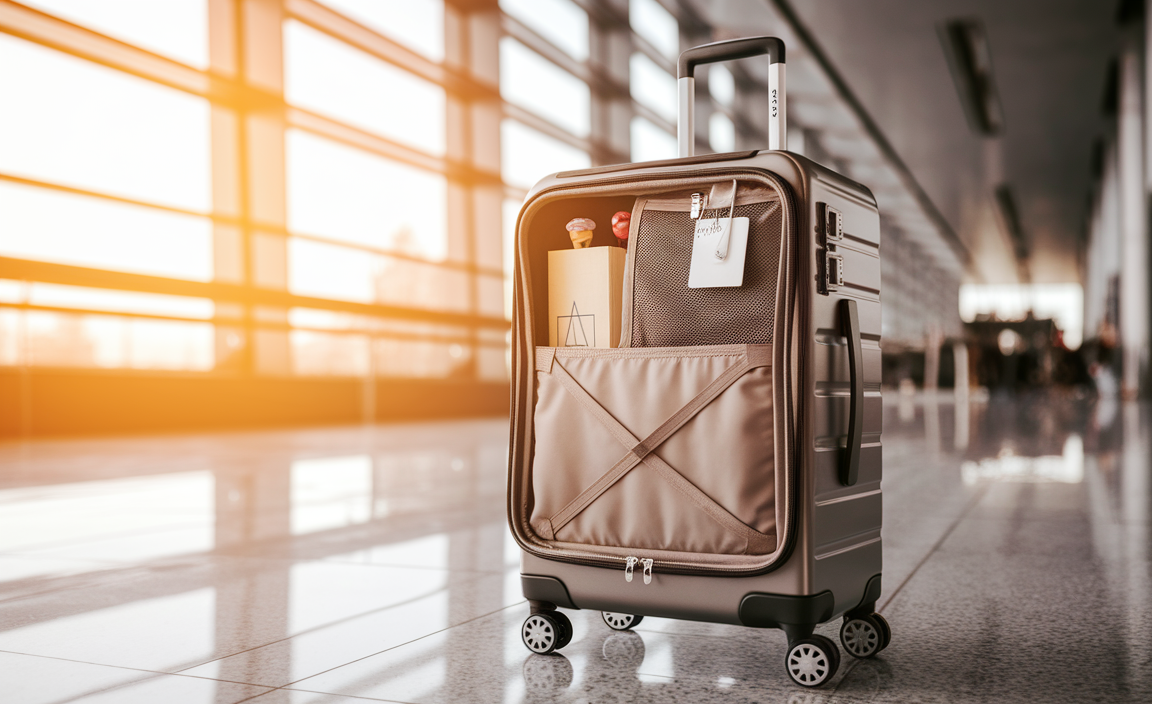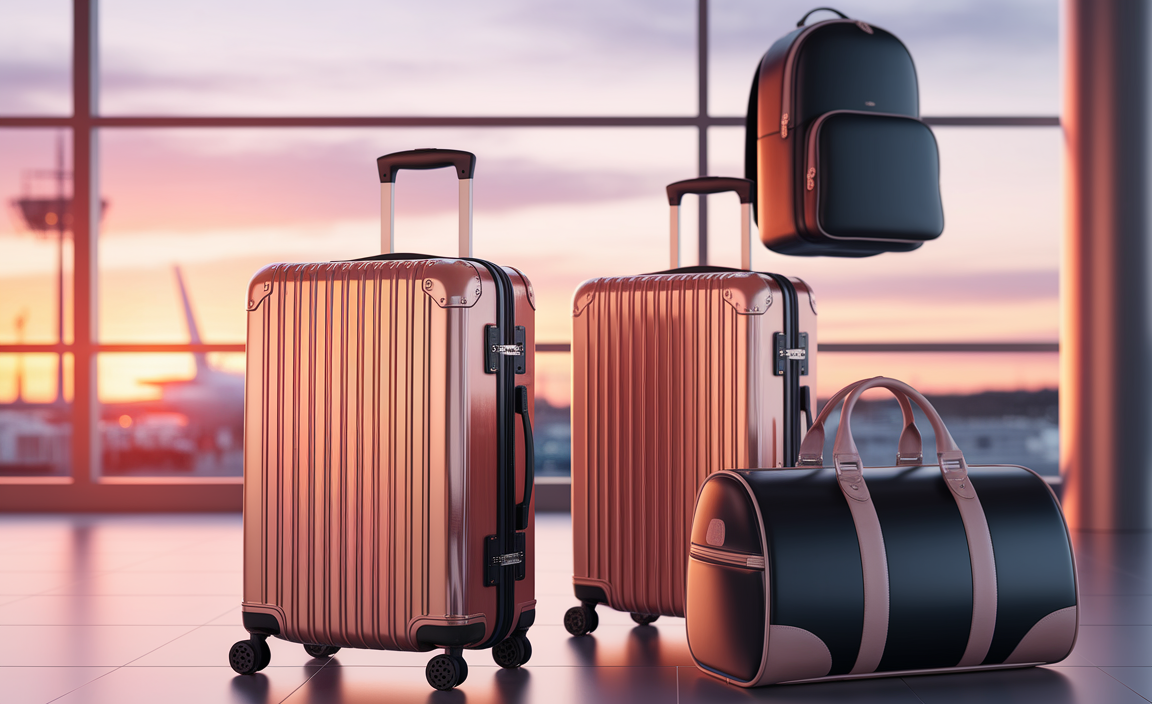Imagine you’re at the airport, excited for a new adventure. You get to the gate, but wait—your carry-on luggage doesn’t fit in the overhead bin. Has this happened before? Knowing the sizes for carry-on luggage is key. It can save time and avoid stress.
Did you know airlines often have different size rules? Yes, they do! This can lead to surprises at the check-in counter. Once, a man tried to stuff a large teddy bear in his carry-on bag. It didn’t work! Make sure your bags fit well to travel smoothly. Shall we dive into learning more?

A Comprehensive Guide: Sizes For Carry On Luggage

Ever wondered why a suitcase doesn’t fit in the overhead bin? The secret lies in the size! Airlines have different rules. Most allow bags up to 22 x 14 x 9 inches. Think of packing your favorite toys or books—each fitting neatly inside. Why do we have limits? It’s to make travel smooth. Fun fact: some airlines let you bring an extra personal item. Perfect for adding a snack or a comic book for long flights!
Dimensions and Measurements for Luggage
Standard dimensions for carryon luggage. How to measure luggage size correctly. Choosing the right suitcase size can be like picking the perfect outfit—it needs to look good and fit well. For carry-on luggage, airlines usually allow a standard size of around 22 x 14 x 9 inches. But airlines have different rules, so double-check before you pack. To measure your luggage, grab a tape measure and check the height, width, and depth. And remember, don’t stuff your suitcase like a turkey on Thanksgiving; it might swell up and not fit!
| Dimension | Standard Size (Carry-On) |
|---|---|
| Height | 22 inches |
| Width | 14 inches |
| Depth | 9 inches |
Types of Carry-on Luggage and Their Sizes

Carry-on luggage comes in different forms. Each has its own benefits and sizes. Want a reliable suitcase? Choose between hardside and softside. Hardside is sturdy and often measures 22 x 14 x 9 inches. Softside is flexible and can fit in tight spaces, often around the same size.
Travel backpacks are great for keeping hands free. Most airlines allow them if they are under 18 x 14 x 8 inches. Duffel bags are flexible, too. They must be cabin-approved, typically no larger than 22 x 14 x 9 inches.
What is the biggest size for carry-on luggage?
Most airlines let you carry on luggage that measures up to 22 x 14 x 9 inches. Double-check before flying!
Can backpacks be considered carry-on luggage?
Yes, backpacks are often considered carry-on. They should fit within airline size limits. Check with your airline to be sure.
Pros and Cons of Different Carry-On Sizes
Benefits of maximizing carryon size. Potential downsides and restrictions from larger sizes.
Carry-on luggage comes with its own set of perks and pitfalls. Opting for larger carry-on sizes can offer some surprising benefits. You get more space to pack, meaning you can fit in extra socks or that plush penguin you can’t leave behind. However, with bigger bags, there’s a downside—airlines can have strict size restrictions. Getting stopped at the gate is like having popcorn stuck in your teeth right before a photo. Nobody wants that! Always check the airline guidelines to avoid surprise charges!
| Pros of Larger Carry-Ons | Cons of Larger Carry-Ons |
|---|---|
| More packing space | Strict airline size limits |
| Less need to check-in baggage | Potential extra fees |
Using the biggest legal carry-on can save you from waiting at baggage claim—a place where time goes to nap. On the flip side, not all airlines love hefty bags. While it seems to promise more room, handling a large carry-on can feel like trying to cuddle a bear. Ensuring it’s spill-proof is key. Getting it all right feels like solving a puzzle—one with vacation vibes!
Packing Tips for Different Luggage Sizes

Efficient packing strategies based on size. Essential items to prioritize in limited space. Ever tried packing a suitcase and felt like you were fitting clowns into a mini car? For different luggage sizes, strategies shift. In a small carry-on, every inch counts! Roll clothes to save space, and use shoe interiors to stash items. Prioritize toiletries in travel-size containers. Think essentials first: passport, toothbrush, and that favorite teddy bear. For larger bags, pack heavier items like shoes at the bottom for stability.
| Luggage Size | Packing Tip |
|---|---|
| Small Carry-On | Roll clothes, use every nook |
| Medium Suitcase | Layer clothes by weight |
| Large Suitcase | Bottom heavy for balance |
Mastering the art of packing can make you a travel ninja. Mark Twain once said, “Travel is fatal to prejudice,” but so is forgetting your socks! Happy packing!
Adapting to Updated Security and Size Regulations
Recent changes in security checks affecting size allowances. How to stay informed about future regulatory changes.
Every traveler must stay updated on luggage rules. Airports have strict security checks. These change often, affecting size allowances. To avoid surprises, check airline websites before flying. Sign up for alerts. They send news about rules. Keep measurements handy. Double-check them with bags. It saves time and trouble. Remember, being prepared means smoother trips!
Why have size regulations for carry-on luggage changed?
Airports enforce these changes to enhance safety and speed up lines. More people travel today. Airlines need to fit more bags in planes. Plus, using safety devices is essential for good protection.
Following the rules keeps every trip stress-free. There are fewer delays, more happy moments. Adjusting to new rules is easy when informed. Smart travelers plan ahead!
Choosing the Right Carry-On for Your Travel Needs
Factors to consider when selecting carryon sizes. Recommendations for frequent travelers vs. occasional flyers.
Finding the right carry-on can make your trip smooth. Size matters. Airlines have different rules for carry-on bags. Always check them before your flight. Think about how often you travel.
- For frequent travelers, choose a sturdy bag with good wheels.
- For occasional flyers, a lighter option works.
Here are some factors:
| Frequent Travelers | Occasional Flyers |
|---|---|
| Durability | Lightweight |
| More space | Basic design |
### Can a 22-inch bag be a carry-on? Yes, 22-inch bags often fit carry-on rules. Yet, airline limits vary. Always measure and check before you go.
Choosing wisely saves time and stress. Good luggage lasts long and helps at the airport. Remember, the right carry-on fits your travel style and the airline’s rules. As the saying goes, “Pack light and travel easy.” This truth holds for many seasoned travelers.
Conclusion
In summary, carry-on luggage sizes vary by airline. Always check airline guidelines before packing. Choose a bag that fits overhead bins or under seats. This helps avoid travel hassles. Now, explore online sources for specific airline rules and tips on packing light. Happy traveling!
FAQs
What Are The Maximum Dimensions Allowed For Carry-On Luggage In Most Airlines?
Most airlines let you bring a bag on the plane. This bag can be 22 inches tall, 14 inches wide, and 9 inches deep. It’s like having a small suitcase with you. You can keep it in the space above your seat.
How Do Carry-On Size Restrictions Vary Between Domestic And International Flights?
When we fly, different airlines have rules about how big our carry-on bag can be. On domestic flights, within the same country, airlines usually let us bring a smaller bag. But on international flights, between countries, the rules can change, and sometimes they allow a little bigger bag. We should always check with the airline before we pack!
Can A Personal Item, Like A Backpack Or Purse, Be Considered As Carry-On Luggage, And What Size Should It Be?
Yes, a backpack or purse can be considered carry-on luggage. This means you can take it with you on the plane. It should fit under the seat in front of you. A good size is about 18 x 14 x 8 inches. Always check with your airline, as they might have different rules.
Are There Specific Size Requirements For Carry-On Luggage When Flying With Low-Cost Carriers Compared To Major Airlines?
Yes, there are specific size rules for carry-on luggage. Low-cost airlines often have smaller size limits. Major airlines usually allow bigger carry-ons. Always check the airline’s rules before you pack to be sure your bag fits.
How Can Travelers Measure Their Carry-On Luggage To Ensure It Meets Airline Specifications?
To measure your carry-on luggage, you need a measuring tape or ruler. Check the airline’s rules for how big your bag can be. Measure the bag’s length, width, and height. Make sure your bag isn’t bigger than the limit. If it fits, you’re good to go!
Resource:
Airline baggage size policies: https://www.tsa.gov/travel/travel-tips/what-expect-airport
Tips from seasoned travelers: https://www.smartertravel.com/how-to-pack-a-carry-on-bag/
International carry-on size chart: https://travel.usnews.com/features/airline-carry-on-luggage-size-guide
Guide to choosing luggage: https://www.realsimple.com/work-life/travel/travel-gear/best-carry-on-luggage








